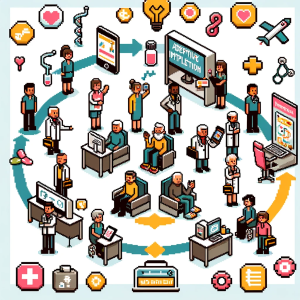
Telehealth: Bridging Gaps and Revealing Divides in Healthcare Access
The digital revolution in healthcare, especially telehealth, has been a beacon of hope for improving medical access across diverse populations. The article Telehealth and digital health innovations: A mixed landscape of access published in PLOS Digital Health, provides a comprehensive analysis of this evolving landscape. This blog aims to distill the essence of this insightful article for public health practitioners, emphasizing the benefits, risks, and critical role of digital determinants in shaping the future of healthcare.
Unpacking the World of Telehealth
Telehealth, encompassing remote medical interactions via technology, emerged as a frontline warrior during the COVID-19 pandemic. Its rapid adoption illuminated its potential to significantly expand healthcare access. However, the journey hasn’t been without bumps. The reliance on technology has unintentionally widened the gap for those in “healthcare deserts” or with limited digital literacy.
The Bright Side: Expanding Access
Telehealth shines in its ability to reach underserved areas and cater to individuals with disabilities, reducing the need for physical travel. Video conferencing can also minimize provider biases based on physical appearance, promoting a more inclusive healthcare environment.
The Other Side: Digital Divides
Despite these advantages, telehealth amplifies existing disparities. Those without reliable internet or digital literacy are inadvertently sidelined. Additionally, the adaptation of healthcare systems to predominantly online services could neglect the needs of those who cannot easily access or afford these technologies.
Digital Determinants of Health: A New Frontier
The concept of Digital Determinants of Health (DDoHs) emerges as a crucial factor. It encompasses factors like digital literacy, access to technology, and reliable internet connectivity. These determinants play a pivotal role in the adoption and effective use of telehealth services, especially in marginalized communities.
The Role of Broadband Infrastructure
Access to robust broadband is a cornerstone for successful telehealth implementation. However, in many rural or economically challenged regions, this remains a significant hurdle, perpetuating the digital divide.
Navigating Natural Disasters
The stability of the electrical grid, crucial for telehealth, can be compromised by natural disasters. Events like hurricanes can disrupt telehealth services, critically affecting those dependent on electronic medical support.
Systems Engineering: A Path to Inclusive Telehealth
Adopting a systems engineering approach can address these challenges, ensuring telehealth is accessible and equitable. This approach calls for holistic consideration of patient needs, taking into account various social and functional disabilities.
Overcoming Barriers in Clinical Workflow
Telehealth relies heavily on digital systems, which often assume a certain level of user familiarity. From electronic health records to scheduling systems, these digital interfaces must be intuitive and accessible to all, including those with disabilities.
The Importance of Consent and Privacy
The digital nature of telehealth also brings forth concerns about consent and privacy. Simplifying and making the consent process more transparent is essential to maintaining patient trust and autonomy.
Looking Ahead: Recommendations for a Digital Health Future
The article concludes with actionable recommendations for public health practitioners:
- Design for Accessibility: Emphasize user-friendly interfaces and value-sensitive design to accommodate diverse needs.
- Support Diverse Technologies: Ensure compatibility with a range of devices and settings, recognizing the varied technological access among patients.
- Embrace Diversity in Users: Acknowledge and cater to the diversity of users, including their preferred modes of communication and identities.
- Facilitate Repair and Accountability: Develop mechanisms for feedback and improvement, ensuring that technology evolves in response to user needs.
A Balanced View of Telehealth
In essence, telehealth holds immense potential for transforming healthcare delivery. However, its success hinges on addressing the digital divide and ensuring equitable access for all. Public health practitioners play a crucial role in navigating these challenges, advocating for policies and technologies that bridge gaps rather than widen them.
Unlock Your Public Health Potential – Subscribe Today!
Join the ranks of proactive change-makers with ‘This Week in Public Health.’ Elevate your understanding and engage directly with the latest in community health, innovative research, and advocacy. Every issue is more than just news – it’s a stepping stone to making a real difference. Subscribe for free now and be the change-maker in public health!



